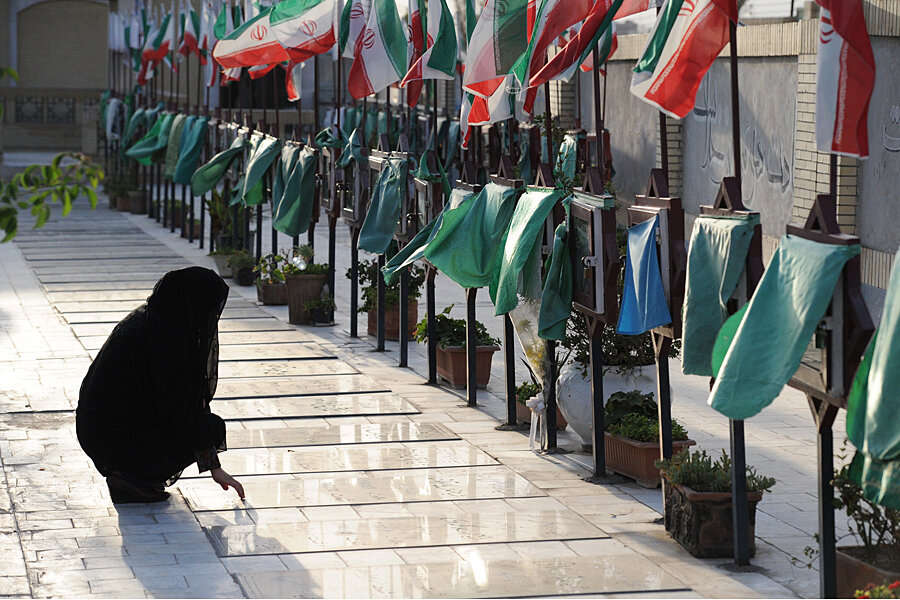In Southeast Iran, mourning the cost of a Sunni insurgency
Loading...
| Zahedan, Iran
Draped in elegant dark robes and with reverent steps, the woman walks past scores of gravestones set flat in the ground – part of the toll from more than a decade of a slow-burn Sunni insurgency.
In this cemetery near Iran’s remote border with Pakistan and Afghanistan and beside high rocky hills, the desert wind blows Iranian flags above each grave, and rustles faded fragments of green cloth hung to protect every martyr’s portrait from bleaching by the sun.
No single death may mean much for Iran’s long battle with Pakistan-based Jaish al-Adl (Army of Justice). But its insurgency, with its flashes of large-scale bloodletting in mosques and attacks against Iranian soldiers, has caused a chronic sense of insecurity in Sistan-Baluchistan Province, an impoverished Sunni tribal region.
Tehran is trying to strengthen this neglected region's economy and to deescalate the conflict in order to better focus on more strategic issues facing Iran – including the Islamic State's challenge to Iraq and the civil war in Syria. In a visit to Zahedan last April, President Hassan Rouhani vowed to step up investment to ease local grievances, and stated that no Iranians – be they Sunni or other minorities – are “second-class citizens.”
“Now the heads of the country and officials are joining hands and getting rid of local problems, to deal with the enemy outside – and there are many enemies outside,” says Molavi Abdulqani Barani, a Sunni cleric from Zahedan.
At the cemetery, Shima Nezami stops, kneels down, and gently taps her fingers on the grave of her brother-in-law. He died in a double suicide bombing on the Shiite Jamia mosque in July 2010 that killed more than 27 and wounded 10 times that number.
“We are all living our lives, but you can’t imagine the loss of this son for the mother and father,” says Mrs. Nezami about Yasir Nezami. He was 23 years old when he died, just four days away from receiving his degree in IT engineering.
“A lot of people died here for no reason,” says Nezami, still crestfallen. “When anyone sees an opportunity for terrorism, they will take it.”
Only three people died in the first blast; the second explosion, timed to go off 20 minutes later and kill those – like engineer Nezami – who raced to help, accounted for the rest. Militants claimed the attack was in revenge for Iran capturing and killing their leader Abdolmalek Rigi months earlier.
Iranian officers claim to have now made security “perfect” after a recent surge of attacks from Sunni militants coming from Pakistan – some of those attacks using tactics similar to Islamic State actions in Iraq and Syria.
But the two long rows of graves here, and the stories behind them, mean that not all are convinced. Iran’s previous presidents also vowed improvements, with limited results. Jaish al-Adl, formerly called Jundallah (Soldiers of God), claims to fight for greater rights for Iran’s minority Sunnis and ethnic Balochis; analysts say they lack popular support.
“Nobody comes to our city because of insecurity; none of the men [officials] come to our region because of insecurity,” says Nezami, as her husband arrives to pay his respects to his brother, a weekly ritual. “We are not capable of moving. If so, we would not stay here another moment."
“Their goal is to create disunity, but they have not succeeded,” says Shahriar Nezami, more defiantly, of the militants. “People that are wise and more educated know this doesn’t affect the brotherhood of Sunnis and Shiites.”
Nezami’s grave is beside that of the man who is seen as a local hero for his actions at the mosque. He was the first to notice that an over-size person wearing an all-enveloping burqa was not a woman, but a militant wearing a suicide vest. He died preventing the bomber from entering the mosque – an elaborate structure covered in exquisitely designed blue and green tiles. Today that green metal door is still bent with the force of the blast, and pierced like the marble wall with holes of shrapnel.








